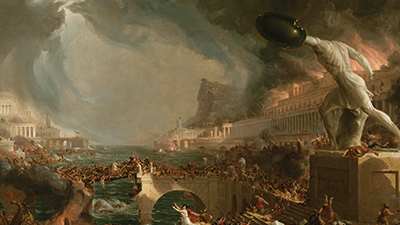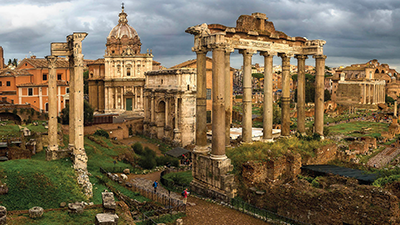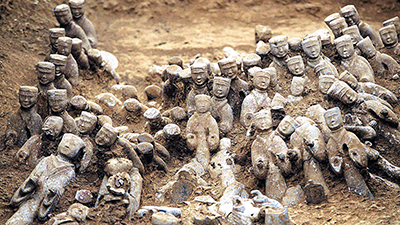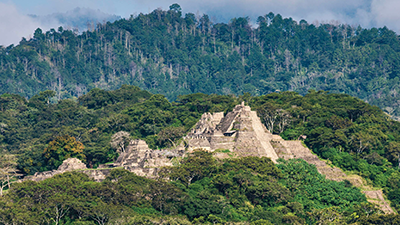Why Do Empires Collapse?
Teacher Resources
Driving Question: What are the most important factors leading to the collapse of empires?
Empires always fall—but how and why depends on leaders’ choices and the challenges they face. By comparing different collapses, we can uncover the biggest causes of chaos and see what they reveal about the past, the present, and the future.
Learning Objectives:
- Analyze historical narratives of collapse and evaluate how they might shape our understanding of today’s societies.
- Evaluate the legacy and collapse of the Han Dynasty and Roman Empire.
- Use the historical thinking practice of causation to understand how and why societies collapse.
Vocab Terms:
- administrative
- barbarian
- catastrophe
- decline
- dowager
- imperial
- romanitas
Opener: Why do Empires Collapse?
To teach this lesson step, refer to page 2 of the Lesson 5.2 Teaching Guide.
Take a look at the Causation Page for a wealth of materials that address this important skill.
Just as societies rise, they also fall. In this activity, you’ll preview how some of these stories of collapse begin.
Empires Collapse
To teach this lesson step, refer to page 3 of the Lesson 5.2 Teaching Guide.
Take a look at the Writing Guide for support as students dig into their Claim and Focus skills.
How do empires collapse? Invasion, lack of money, and internal challenges are three major reasons, as many ancient empires discovered.
-
Guiding Questions
-
Before you read
Preview the questions below, and then skim the article. Be sure to look at the section headings and any images.
While you read
Look for answers to these questions:
- What are two general factors that usually bring down an empire?
- How might changes in population affect an empire?
- What was a problem shared by some emperors in both Rome and the Han Dynasty?
- What factors made it easier for Alexander to conquer Persia?
- Why did the Spanish have lucky timing when they took over former Inca territory?
After you read
Respond to this question: Are there any lessons we can learn from the collapse of these empires that might help us think about how to keep our own society from collapsing?
Fall of Roman and Han Empires
To teach this lesson step, refer to page 4 of the Lesson 5.2 Teaching Guide.
OER Project teachers love Autopsy of an Empire. Learn more about their approaches in the Autopsy of an Empire forum conversation.
Get ready to dig into the remains of some of history’s greatest empires. In the next set of materials, you’ll explore how even the most powerful political forces can falter.
-
Guiding Questions
-
Before you read
Preview the questions below, and then skim the article. Be sure to look at the section headings and any images.
While you read
Look for answers to these questions:
- Why did the Romans concede land to the German tribes?
- What were some key differences between the eastern and western parts of the Roman Empire?
- What are some reasons that the Roman economy was weak?
- What did the Antonine Constitution do?
- What was left of Rome after 476 CE?
After you read
Respond to this question: How did changing ideas about community help the Roman Empire thrive at first but later contribute to its decline?
-
Guiding Questions
-
Before you read
Preview the questions below, and then skim the article. Be sure to look at the section headings and any images.
While you read
Look for answers to these questions:
- What are some challenges the Han faced that were outside their control?
- How did Han rulers deal with tribal groups from the border regions?
- What was the Yellow Turban Revolt? How did it affect the emperor?
- What are the three main theories Chinese historians once had for why the Han Dynasty collapsed?
- What’s one modern theory for why the Han Dynasty collapsed?
After you read
Respond to this question: How does the decline and collapse of the Han Dynasty compare to the collapse of the Roman Empire?
Closer: Why do Empires Collapse?
To teach this lesson step, refer to page 8 of the Lesson 5.2 Teaching Guide.
Need a hook for systems collapse? JENGA—check out this conversation in the community forum.
Visual metaphors can be powerful tools for expressing historical events and can help you deepen your understanding.
Writing: Comparing Collapse
To teach this lesson step, refer to page 8 of the Lesson 5.2 Teaching Guide.
In this writing activity, you’ll use evidence from sources to support an argument that responds to the prompt: How did states respond to the societal and political collapse after the fall of the Roman Empire and the Han Dynasty around 1200 CE?
Patterns of Collapse
To teach this lesson step, refer to page 9 of the Lesson 5.2 Teaching Guide.
Collapse can strike any civilization, anywhere. Challenge your thinking with these materials on how and why societies fall.
-
Guiding Questions
-
Before you watch
Preview the questions below, and then review the transcript.
While you watch
Look for answers to these questions:
- How does Jared Diamond define collapse?
- What evidence does Jared Diamond offer in making his argument that societies collapse together?
- What countries did American officials think were the least important to American power during the twentieth century?
- What evidence does Diamond use when he asserts that the environment plays a role in collapse?
- What is Diamond’s point of view on whether or not we are headed for collapse?
After you watch
Respond to these questions:
- How does Jared Diamond argue that collapse in the twenty-first century would be different from any previous collapse?
- Do you agree or disagree with him? Explain your reasoning.
Key Ideas
-
Guiding Questions
-
Before you read
Preview the questions below, and then skim the article. Be sure to look at the section headings and any images.
While you read
Look for answers to these questions:
- How did the Aztecs who found Teotihuacan’s ruins name the ancient city?
- How were Teotihuacan and the cities of the Maya Classic Period similar?
- How were Teotihuacan and the cities of the Maya Classic Period different?
- Why does the absence of a writing system make it hard to determine why an empire falls?
- Why is it difficult to pin the “collapse” of a society on a single cause?
After you read
Respond to this question: How does evidence from Teotihuacan and Maya societies contribute to your understanding of what “collapse” means?










